What The Monopoly Properties Look Like In Real Life
Whenever I played Monopoly as a kid, I used to love imagining what the game’s city would look like in real life. I remember thinking of Mediterranean and Baltic as being these short, run-down alleys ala West Side Story, while Pennsylvania Ave and the other greens as Fifth Avenue-style apartment buildings.
What I didn’t know back then was that the properties in Monopoly were in fact named after the streets of Atlantic City. Monopoly itself has a long and complicated history, but the addition of Atlantic City-based street names can be traced to one Ruth Hoskins. Hoskins had learned a version of the game in Indianapolis, and upon moving to Atlantic City in 1929, made her own copy from scratch naming properties after streets where her friends lived.
This past weekend, I was driving through south Jersey, and decided to make a quick detour through Atlantic City to see what the Monopoly board looks like in real life. Everyone have their tokens picked out?
Mediterranean Ave: Running northeast through the city, Mediterranean Ave mostly consists of low-rise residential properties. On Hoskins’s original board, this was named Arctic Avenue; it was later changed to Mediterranean by Charles Darrow (once popularly considered to be Monopoly’s sole creator) because he liked the warmer feel of the name.
Baltic Ave: Who would expect to find a J. Crew on the corner of Baltic Ave?? Thought it might be second cheapest property on the board, Baltic today actually has a thriving strip of retail stores right as you enter the city.
Oriental Ave: Running a scant 10 blocks in the southeastern-most corner of Atlantic City, the selling point is probably the Revel casino at the south end, but I personally like this strip of row beach houses. The one on the end even has an over-sized Monopoly deed card hanging above the porch!
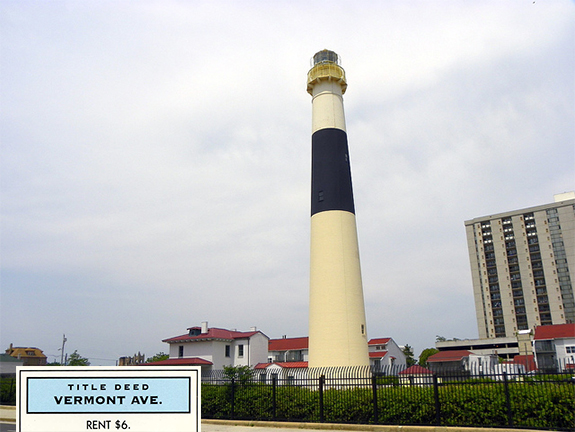
Vermont Ave: The centerpiece of Vermont is the Absecon Light, the tallest lighthouse in New Jersey at 171 feet. Built in 1854, it was officially deactivated in 1933 but still lights up every night. You can now tour a recreation of the keeper’s house, as well as climb to the top of the lighthouse (only 228 steps!).
Connecticut Ave: The most expensive of the light-blue properties runs straight to the boardwalk and nets you the new Revel Casino, which opened in 2012.
St. Charles Place: St. Charles Place is gone forever, built over by the Mardis Gras-themed Showboat Casino in 1987.
States Ave: Just a single block of States Ave remains today, running along the west side of the Showboat Casino.
Virginia Ave: Lined by mostly new residential developments, Virginia Ave ends directly at the Trump Taj Mahal.
St. James Place: St. James Place runs for just a few short blocks, but has some really classic buildings along it that feel like Atlantic City of old. Fun fact: St. James Place is considered one of the most valuable properties in Monopoly (the oranges are the most landed-on group in the game).
Tennessee Ave: Tennessee Ave runs pretty much the whole length of Atlantic City. Property owners can count a Super 8 and the NJ Casino Control Commission among their possessions!
New York Ave: The plethora of vacant lots waiting for development is pretty depressing, especially when you consider that a lot of original buildings were probably torn down to make way.
Kentucky Ave: Lots of parking here for the historic Madison Hotel, which dates to 1929. Closed since 2006 (yes, I would love to explore those empty halls), it was purchased in 2013 for $4 million with plans to reopen.
Indiana Ave: Indiana Ave nets you the backside of Bally’s.
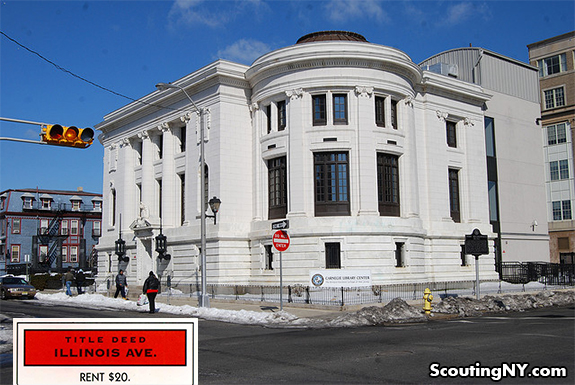
Illinois Avenue: Illinois Ave still exists but was renamed Martin Luther King Jr. Blvd in the 1980s. The deed holder of Illinois can count one of the most beautiful buildings in Atlantic City among his properties: the Carnegie Library. Founded in 1903, it was used as a public library until 1984, when the library moved to a larger space. The building was abandoned in 1994 and remained that way for seven years. It was finally renovated in 2001 and is now used by Stockton College as a library center.
Atlantic Ave: As far as I can tell, Atlantic Ave is the longest street on the island, running over 8 miles from Atlantic City to Longport. It’s also one of the most commercial heavy, quite a steal for only $260!
Ventnor Ave: And now for something completely different…Ventnor Ave runs east-west into Ventnor City, the next town southwest of AC. It’s mostly residential, and gets nicer as you head west.
Marvin Gardens: Marvin Gardens holds a few unique distinctions. First, it’s the only property not located in Atlantic City (it’s actually in Margate City). Two, it’s misspelled (the real Marven Gardens was a combination of the names Ventnor and Margate). Third, it’s easily the most beautiful property on the Monopoly board. A housing community founded in the 1920s and 1930s, the homes and gardens have been immaculately maintained and are literally picture perfect. Seriously, next time you’re in Atlantic City, make it a point to drive a few miles down the road to check out this dead ringer for the town in the Truman Show. Wow.
Pacific Ave: Pacific Ave is the closest thoroughfare running parallel to the boardwalk and thus has a lot of casinos along it (including Caesar’s). If you owned Pacific Ave in real life, you’d be sitting pretty.
No. Carolina Ave: Sure, No. Carolina Ave gets you the Resorts casino, but I like this old brick building up the way, with a great wrap-around copper awning.
Pennsylvania Avenue: It’s the third-most expensive property in the game, but Pennsylvania Ave is mainly the backside of Resorts. Hey, you get a bus depot!
Park Place: Park Place was indeed named for a park, but that park is now gone, built over by Bally’s. Today, Park Place is a small stub of a road adjacent to Brighton Park. Fun fact: Park Place is one of the least landed-on spots in the game.
Boardwalk: Perhaps the most famous board game space in history, the real Atlantic City boardwalk was the first of its kind in the United States, having opened in 1870. While much has been modernized, bits of the past – like wooden planks and push carts – offer a wisp of what once was. A plaque commemorating Charles Darrow can be found at the corner of Park Place & Boardwalk, which do intersect.
And that brings us back to GO.
-SCOUT

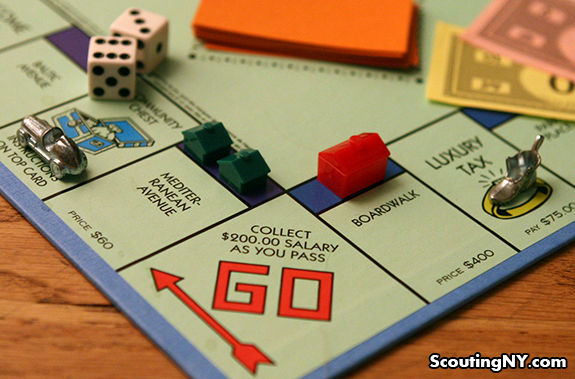


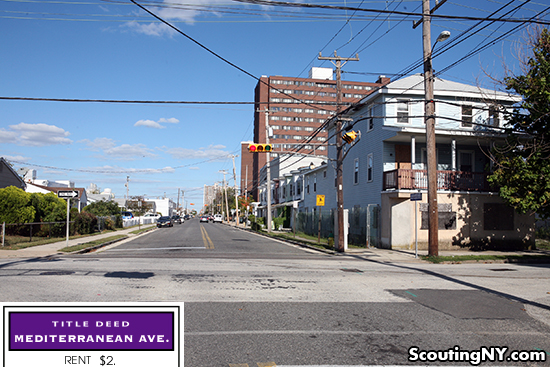
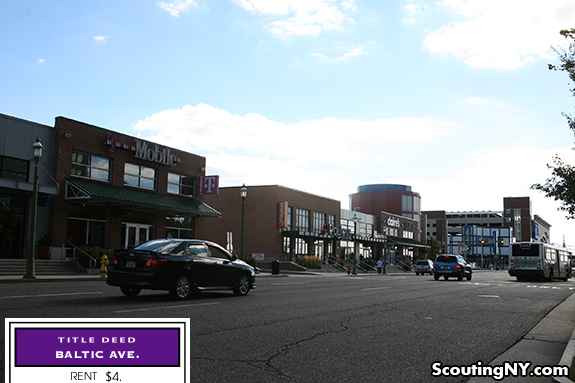
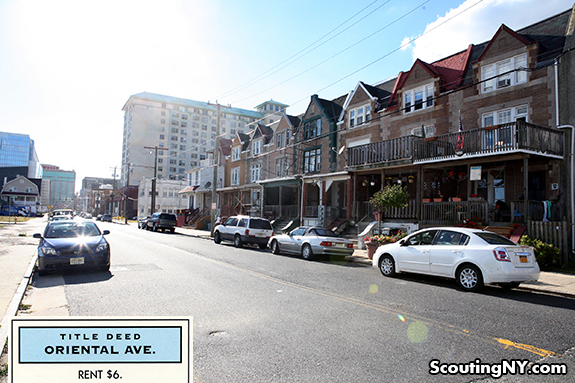

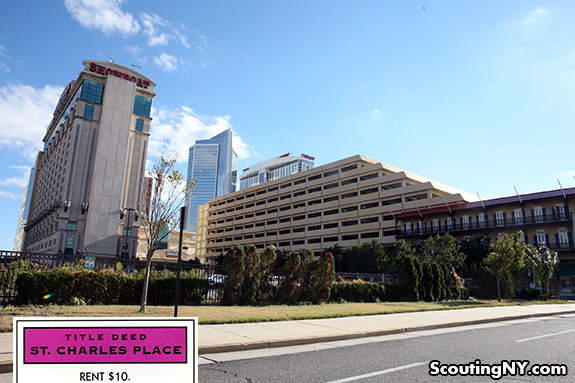
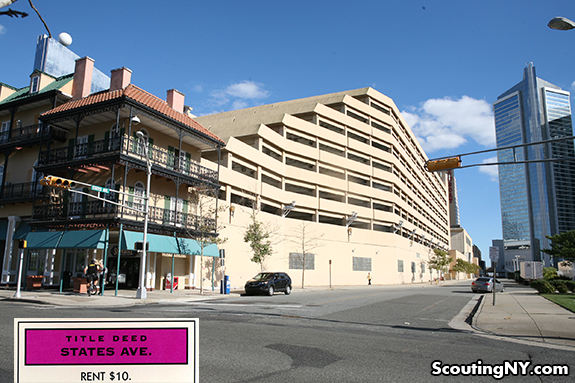


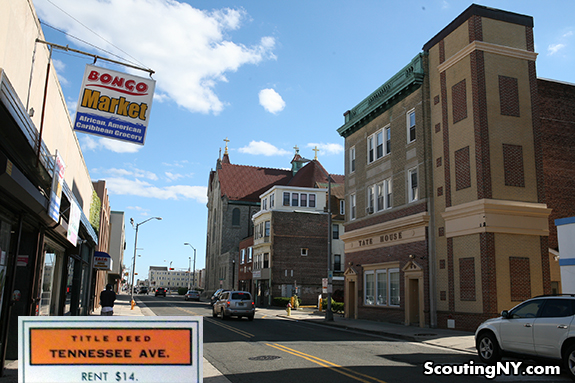
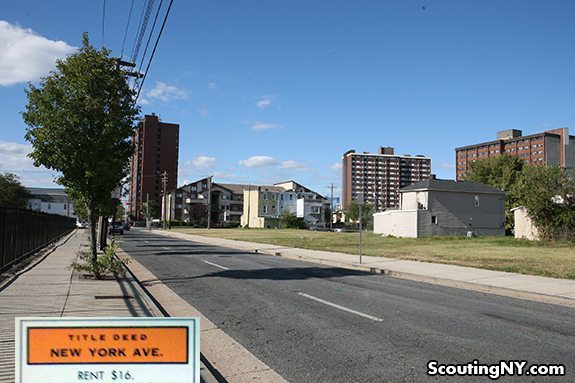
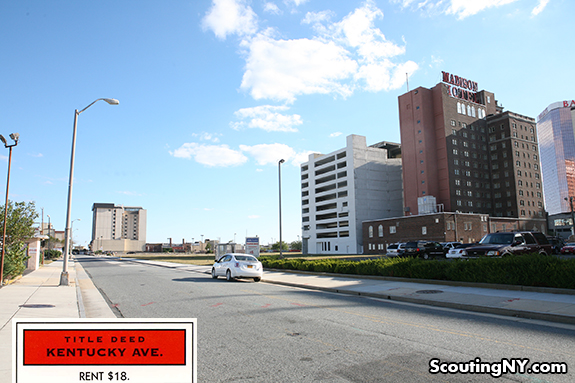
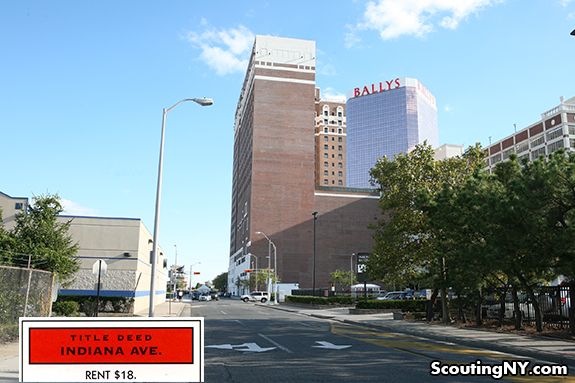

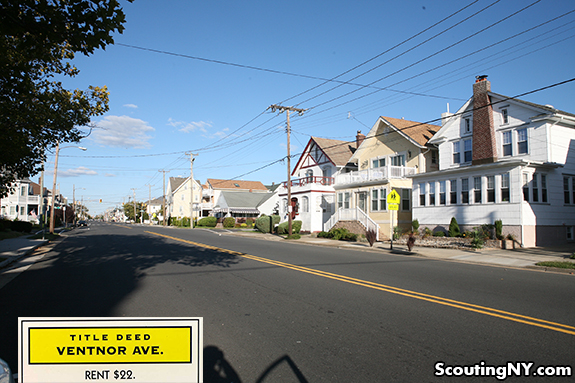
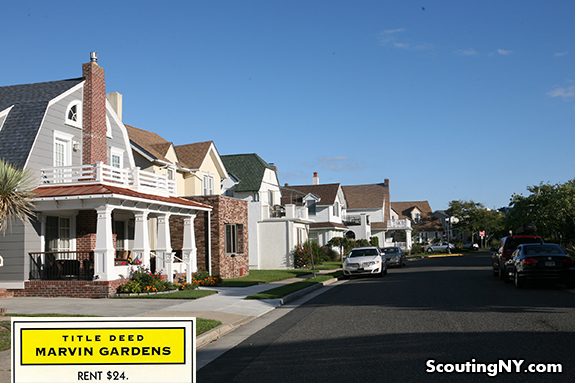
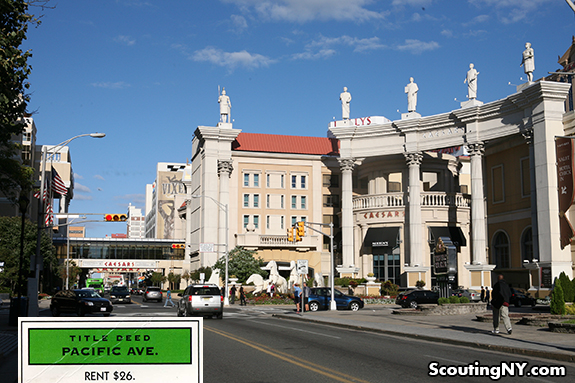
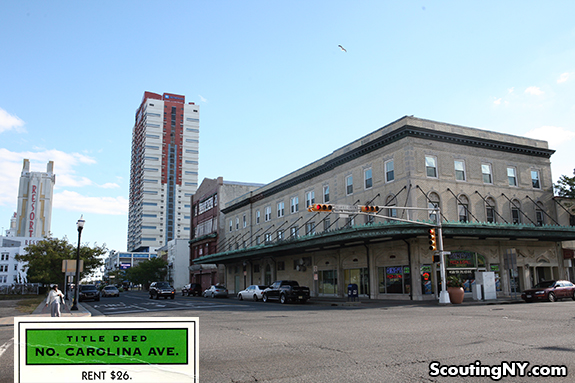
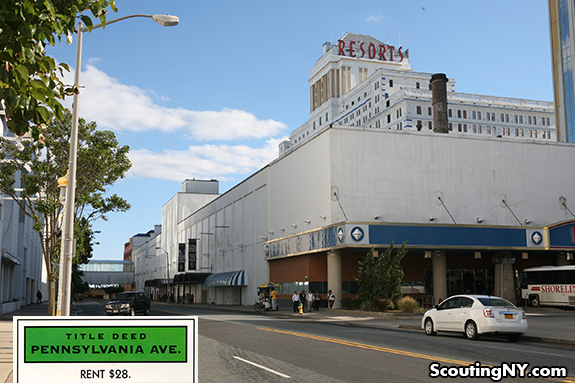
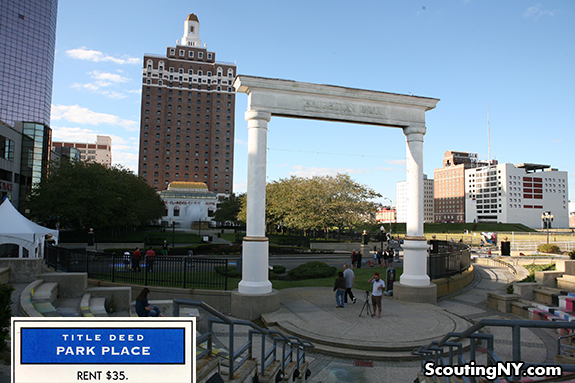
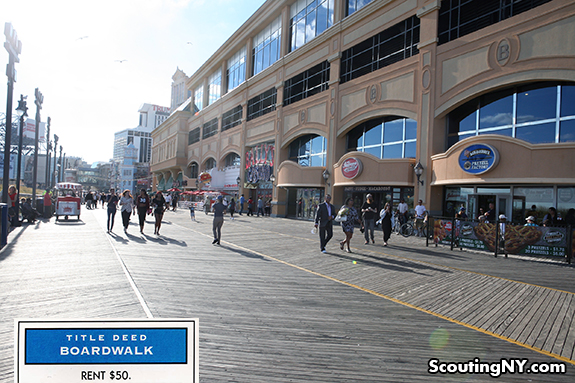
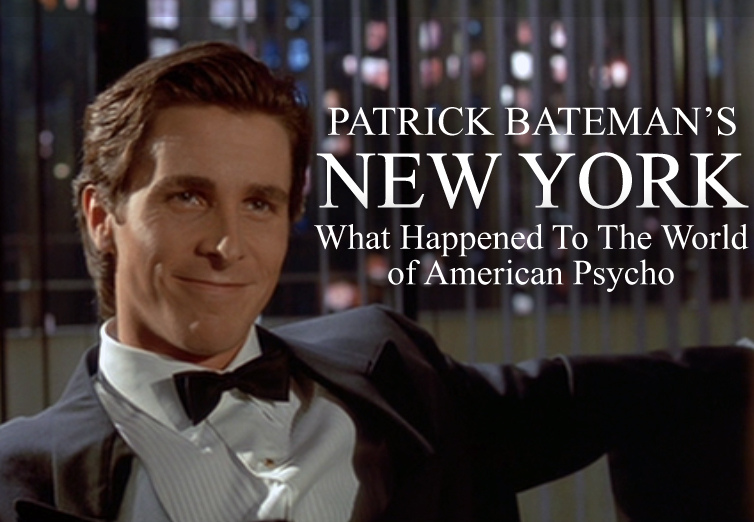
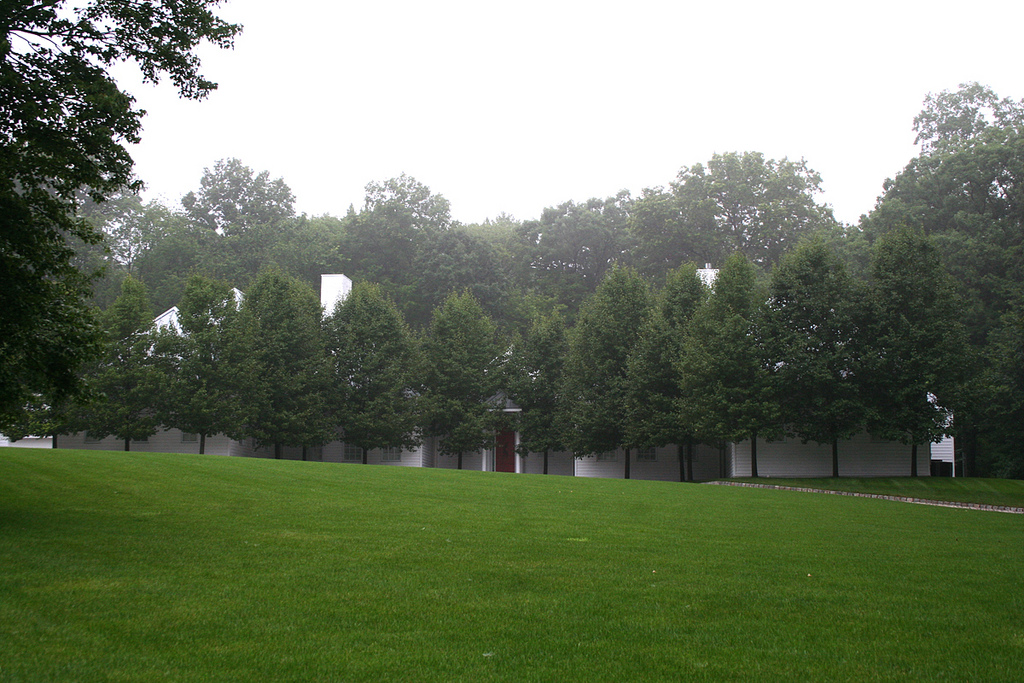

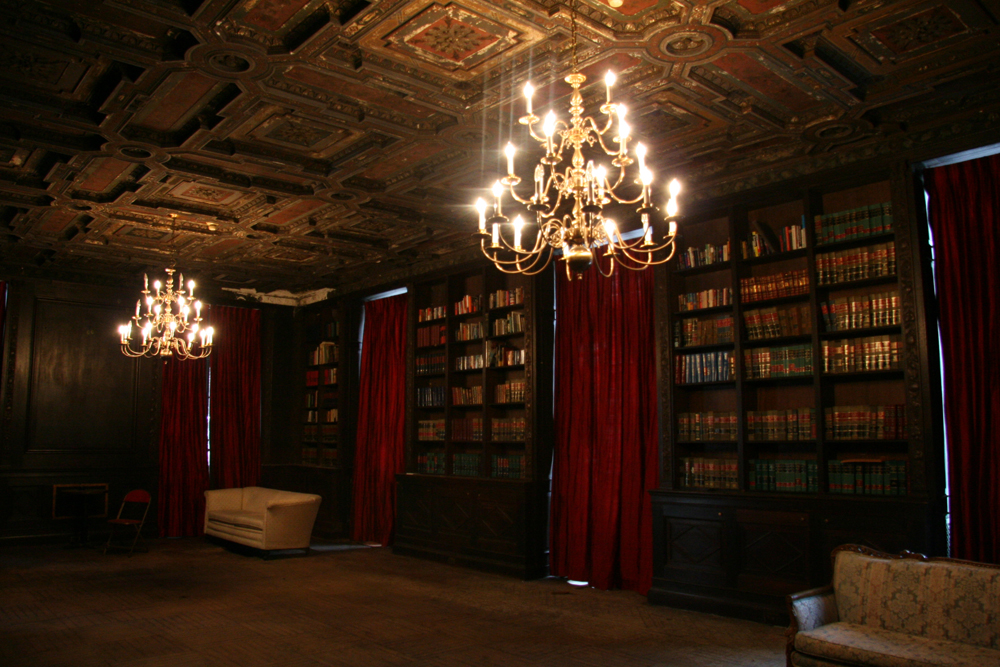
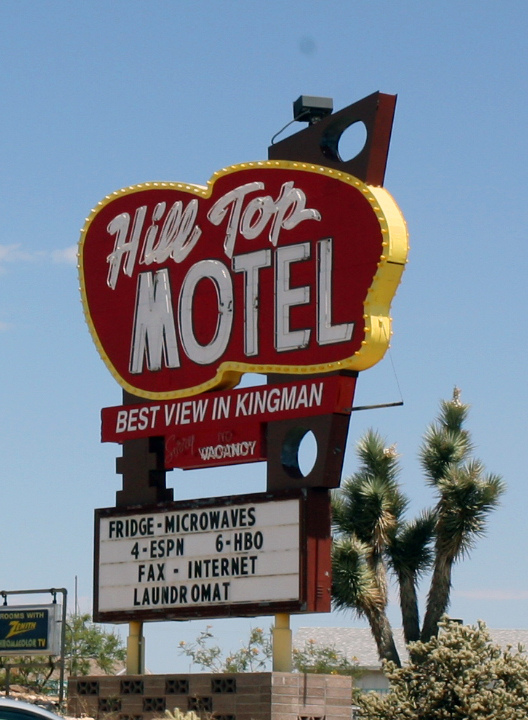
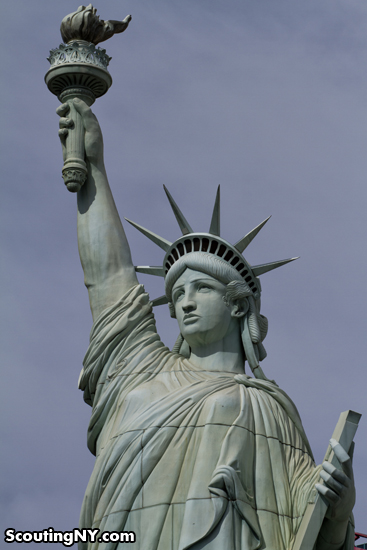
Very interesting! On a side note, Ocean City, NJ, which lies about 11 miles south of Atlantic City still has a street named St. Charles Place. At the end of St. Charles, you’ll find the OC boardwalk & Brown’s Donuts, an Ocean City Institution.
I was on my way to Jersey, to visit my late husbands family, I got lost and ended up in OC!! I wanted to stay there!! LOL
instead of going over the bridge, we ended up on the St. Lewes ferry!
was a nice ride, until we realized we were NOT going the right direction!
Last weekend? Strange weather on Illinois Avenue!
The Illinois Ave photo is from a different Flickr user and was taken in February 2010.
I have monopoly in australia, and by default here the properties have always been named after places in england.
You’ve really shown some lovely pics of AC. Thanks for the enjoyable and positive article!
love that that one house has the deed card. Thanks for this. Keep it up! 🙂
To see more you should read the classic essay “The Search for Marvin Gardens.”
http://m.newyorker.com/archive/1972/09/09/1972_09_09_045_TNY_CARDS_000307740
Since you mentioned that Darrow didn’t actually create the core mechanics of the game, but didn’t mention its actual roots, I thought I’d pass on a link to this article about the history of the game: http://harpers.org/blog/2012/10/monopoly-is-theft/?single=1
And as a native of south Jersey who grew up just across the bay from the city, the fact that the thing that comes to mind for most people when they think of AC is based on theft and lies is…well, really quite fitting.
Great post! Thanks for the tour!
What, no ride on the Pennsylvania-Reading-Seashore Line to get you there?
I was also wanting to see what the good side of the Reading RR was. LOL
The Short Line was never a railroad, but a bus line. And the B&O is now CSX.
Short Line is a generic railroad term for any short railroad. They could be connecting lines between large railroads, a short line running off a major railroad to a rural or suburban area, or even a special line created to handle specialized rail operations around terminals or wharves. A city such as Atlantic City might have several short lines with various names other than “Short Line.” I have also felt Short Line in Monopoly refered to this general type of railroad and not a specific line such as B&O or Reading.
Also, Reading Railroad is pronounced like the city in Pennsylvania “Reding” as in the color Red not like what one does to a book.
Hey, you left out the Reading (now mostly NJT or SEPTA, partly NS), B&O (now CSX), Pennsylvania (now mostly Amtrak and SEPTA, partly NS), and Short Line (bus company which is *still operating*).
Surely you could have gotten a photo of a Short Line bus at least! 🙂
Great post! I guess I always assumed that the Monopoly properties were scattered about the country – I didn’t realize they were so geographically close to us in CT. Thanks for sharing the pics.
What a treasure hunt that musta been to drive around to the shot locations. Good job. I appreciate what you have shown here.
This is cool! Being a monopoly fan since childhood makes this even more awesome…thanks!
What about photos of the properties back in the day when the game was published? A side by side comparison maybe?
I loved this. Being from New Jersey originally. It was always a fun fact to know about AC and Monopoly. My first time there when I was older was very exciting to see those names on the street signs.
I like what Chris wrote. About the actual pictures from way back!
Thanks for the photos!
Growing up in Margate, a few blocks from Marven Gardens, I knew that the streets were from Atlantic City but as a kid I never really appreciated how unique it was to have a game with the streets of my town.
BTW, Ventnor Ave. runs through AC, Ventnor, Margate and ends in Longport. Part of it in Margate is renamed the Margate Parkway, and has some fabulous homes from the 1920’s and 1930’s.
Great article–good research!
Brian January
http://brianjanuary.blogspot.com/
Very interesting….
Good job.
I loved that Indiana Avenue is “Indiana Ave nets you the backside of Bally’s.” So much for Indiana’s image. Actually, the backside of a casino is better than the reality that Indiana is the “wart on the backside of progress.” I say that as someone who was born and raised in NJ.
this is the cutest and most interesting blog post I have ever read in my life—-I’m insanely jealous and stolen it for my own blog–giving you credit, of course and a link…….thanks for the cute tour of Atlantic City, New Jersey, too.
chloe louise…the ronnie republic
http://theronnierepublic.blogspot.com/2013/04/david-bowies-london-right-now-that.html
I never knew that Monopoly’s streets were named after ones in Atlantic City! What a great article. Thanks so much for sharing. I am definitely donating to your movie!
I had always imagined that Marvin Gardens was a pretty tree-lined street with old Victorian homes and perfectly manicured gardens. So happy to see that the real Marvin Gardens is almost exactly like I pictured it. 🙂 And thanks for the “Marven” bit of trivia!
one of the most nostalgic, interesting and refreshing articles I have come across in a while…thanks & nice work !
Quick note, in reference to “The Truman Show.” It was filmed in picturesque Seaside, Florida (http://en.wikipedia.org/wiki/Seaside,_Florida) which…actually looks exactly as it does in the movie. Favorite vacation spot of my family’s.
Seeing the names of the streets on the playing cards with the rent amount for each property makes me wonder if anyone has ever edited the game to show current prices. I mean, where can I rent a place for $18? 🙂
This was a great piece! I spend several holidays as a child in Atlantic City and had a blast on the boardwalk visiting casino arcades and psychics. I had no idea they were at all connected to our favorite game 😉
Brilliantly conceived and well executed. Thanks for bringing my childhood memories back to life. Stay well, have great success with your movie.
So cool! Thanks for sharing. I always thought a job like yours would be interesting. Would have loved to have been able to easily share this across my social networks with friends. Why no sharing icons?
Scout,
Thanks for the great peice showing the streets of Monopoly.
I noticed your raising money for a movie.
Check out a quick and easy way to get the word out to yours and mine database.
You can signup and post your cause and be raising additional funds in less than 20 min.
check it out.
I will donate the first 10 bucks if you start your cause and have one of my business associates help spread the word to our databases.
Take care
James
Scout,
Thanks for the great piece showing the streets of Monopoly.
I noticed your raising money for a movie.
Check out a quick and easy way to get the word out to yours and mine database.
You can signup and post your cause and be raising additional funds in less than 20 min.
check it out.
I will donate the first 10 bucks if you start your cause and have one of my business associates help spread the word to our databases.
Take care
James
Where’s the free parking? The Jail? The railroads and utilities?
No Monopoly game ever ends without:
-A fight
-Someone crying
-Someone quitting
-Someone flipping the board over
-Someone accused of stealing from the bank
In my family, it usually ended with all of the above.
~Cheers
We played monopoly that ran for weeks in the ’50’s. It is a treasured part of my youth and I so appreciate this look at the places so cherished on the board. Thank you! dkchristi.com
Has anyone done something similar for the international version of Monopoly – which uses places in London?
Bally’s casino actually used to be called “Bally’s Park Place”.
What an awesome job you have! Scouting locations for movies and then seeing them come to life on the big screen. Must be wonderful to really “see” things that most of us just glance over.
And what a great post this is. Monopoly was huge for us growing up and the games could last for weeks. We would stash the board under our bed in between sessions and then stuff towels in the gap so the cat couldn’t get under there and redistribute the wealth. 🙂
An incredibly interesting and fun article. Nostalgia of all those properties and some actually have hotels on them. I’m going to wear a hat, take my dog & horse, thimble, iron and get in my car to visit them. haha.
I never would have guessed it was so ugly.
I lived there most of my life… walked those streets… one of my favorite games because it reminds me of home.
Should get rid of that damn income tax. I HATE taxes!!!
Enjoyable article. The Carnegie Library on Illinois Avenue would be an awesome convert into a home.
Good thing they left off the Railroads…. grand old READING RAILROAD (pronounced red-ding) is sadly the ‘poorest city in the US.’ Funny because it was widely considered a prime target during WWII and the Cold War for its steel production.
I’ve been to Reading, and I might have to disagree with you on that one, Have you ever been to Camden NJ ? At one time it was a beautiful thriving city, and now one of the worst for poverty and crime.
Charles Darrow did not change Arctiv Ave to Mediteranean. Charles Todd probably did (He also named Short Line Railroad shortened from Shore Fast Line to fit the small palying square space.) He was the person who taught the game to Charles Darrow. The winter of 1932 was exceptionaly cold and the AC Quaker group playing Monopoly liked the Mediteranean warmth better than cold sounding Arctic Ave. Jessie Rayford was the person who ranked and chose the names for the streets. Both Rayford and Todd were friends of Ruth Hoskins.
Nice article, I grew up in South Jersey about 70 miles West of A.C. And I all to well knew the game board as well as the city. The one thing that I did notice that no one mentioned or wouldn’t want to is; where is the free parking?
This boardwalk is older than the one in Coney Island? Find that hard to believe but ok.
Yes it is older.
1870 vs 1923
Congratulations. Looks like Yahoo picked this up.
http://games.yahoo.com/blogs/plugged-in/streets-monopoly-real-life-174923175.html
Several other places that need pictures:
The IRS Office (Income Tax $200)
Community Chest (would this be the United Way?)
Chance – There are plenty of casinos, so I think that was covered
Atlantic City Jail
Atlantic City Electric
Water Works
State Tax Office (Luxury Tax)
I doubt that back in the thirties that there was a single casino in existence… Nevada had the monopoly on that. (and the ?Mob would have kept it that way since they opposed Boardwalk gambling as compitition.)
Thanks for the article. Wow, Atlantic City is a shithole.
This was very interesting and I enjoyed it very much. I also appreciated the comments. Hopefully this history doesn’t get lost.
Being from Toronto, I was looking forward to seeing the FREE PARKING.
I would love to see, if they have the UK version and the real story behind the game is quite fascinating !
A dead-ringer for the town in the Truman show? Or… you could just head down to Seaside, Fla. That’s a pretty good dead-ringer too.
You made the Huffington Post! Congratulations~
I had no idea that all the streets were in one place; I thought they must have been scattered across the USA. But where are the railway stations? I was looking forward to seeing them.
Great post. Born and raised in AC.Left in 1960. Lived on many of the streets on the board. Lived on Vermont Ave, Atlantic Ave, and Madison Ave which becomes Baltic Ave.
Why hasn’t anyone thought to do this before (that I know of)? Brilliant!
Susan Wong and others, there’s a great book by Tim Moore called “Do Not Pass Go” in which he visits every street on the London Monopoly board:
http://www.amazon.co.uk/Do-Not-Pass-Go-Mayfair/dp/0099433869
fun fact 99% of people who play monopoly pronounce Reading rail road wrong it is not ‘Read ing” as most people say it it’s pronounced “Red ing”
you will find very few people in NJ or PA who say it anyway other than
“Red Ing”
in those photos there are too many things missing, for example bums, prostitutes,carriges,bell boys,dirt bags, to name a few.
in those photo they left what atlantic city is all about for example bums, prostitutes ,bell boys ,dirt bags,loosers, to name a few. go make a donation.
Great Presentation.My family built the Madison. We lived there until the government took over the hotels. Wonderful memories.
Great pics. So different from the city I grew up in. The building on North Carolina Avenue with the awning was the William Segal, fruits & vegetable store. Sold beautiful produce. Now it’s a restaurant.
Did you find any Free Parking?
St James Place! The old classic buildings are abandoned but at the end of the street is the *Irish Pub*! Greatest place in AC to have a guinness and a cheap sandwich!
GREAT PHOTOS!
so if i’m looking for crack and a prostitute should I go to Baltic avenue?
I noticed two inaccuracies in your post.
#1 Oriental ave is in the Northeast section of the city, not the Southeast.
#2 Ventnor avenue runs SSW/NNE through AC, Ventnor, Margate and Longport.Most of the cross streets run almost E/W through the cities mentioned.Otherwise, thanks for showing some of the more positive parts of the city.God knows we have taken our lumps.
Greetings,
I commend you on the research put into this and the photos of the updated locations. Everything is accurate especially the directions that most, even some locals are confused. When writing up a tour for visitors, they are told
to picture themselves standing in the middle of Atlantic Ave. with “their backs” facing the ocean. Anything behind is South and anything in front is North. Usually one has to see an old map of the slanted island or speak with the city engineer or city planning employee. I came across this website trying to show St. Catherine’s Pl. now. Perfect.
Thanks for this and good luck in all your endeavours.